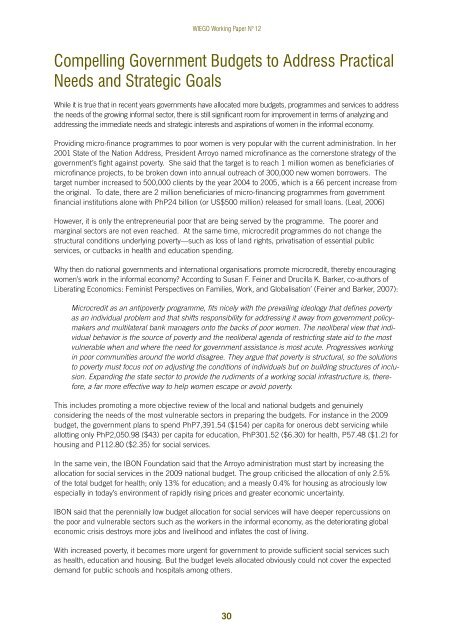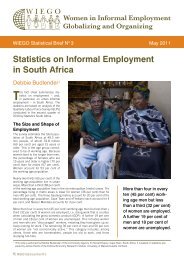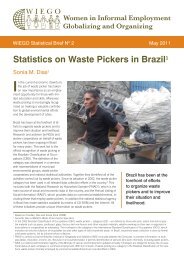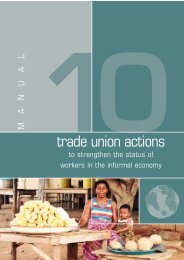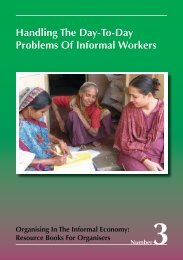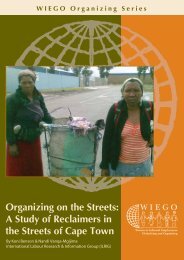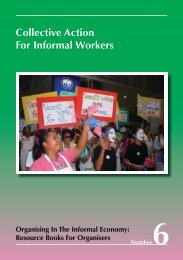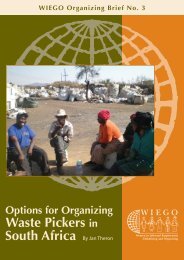Informal Economy Budget Analysis in Philippines and ... - WIEGO
Informal Economy Budget Analysis in Philippines and ... - WIEGO
Informal Economy Budget Analysis in Philippines and ... - WIEGO
You also want an ePaper? Increase the reach of your titles
YUMPU automatically turns print PDFs into web optimized ePapers that Google loves.
<strong>WIEGO</strong> Work<strong>in</strong>g Paper N o 12Compell<strong>in</strong>g Government <strong>Budget</strong>s to Address PracticalNeeds <strong>and</strong> Strategic GoalsWhile it is true that <strong>in</strong> recent years governments have allocated more budgets, programmes <strong>and</strong> services to addressthe needs of the grow<strong>in</strong>g <strong>in</strong>formal sector, there is still significant room for improvement <strong>in</strong> terms of analyz<strong>in</strong>g <strong>and</strong>address<strong>in</strong>g the immediate needs <strong>and</strong> strategic <strong>in</strong>terests <strong>and</strong> aspirations of women <strong>in</strong> the <strong>in</strong>formal economy.Provid<strong>in</strong>g micro-f<strong>in</strong>ance programmes to poor women is very popular with the current adm<strong>in</strong>istration. In her2001 State of the Nation Address, President Arroyo named microf<strong>in</strong>ance as the cornerstone strategy of thegovernment’s fight aga<strong>in</strong>st poverty. She said that the target is to reach 1 million women as beneficiaries ofmicrof<strong>in</strong>ance projects, to be broken down <strong>in</strong>to annual outreach of 300,000 new women borrowers. Thetarget number <strong>in</strong>creased to 500,000 clients by the year 2004 to 2005, which is a 66 percent <strong>in</strong>crease fromthe orig<strong>in</strong>al. To date, there are 2 million beneficiaries of micro-f<strong>in</strong>anc<strong>in</strong>g programmes from governmentf<strong>in</strong>ancial <strong>in</strong>stitutions alone with PhP24 billion (or US$500 million) released for small loans. (Leal, 2006)However, it is only the entrepreneurial poor that are be<strong>in</strong>g served by the programme. The poorer <strong>and</strong>marg<strong>in</strong>al sectors are not even reached. At the same time, microcredit programmes do not change thestructural conditions underly<strong>in</strong>g poverty—such as loss of l<strong>and</strong> rights, privatisation of essential publicservices, or cutbacks <strong>in</strong> health <strong>and</strong> education spend<strong>in</strong>g.Why then do national governments <strong>and</strong> <strong>in</strong>ternational organisations promote microcredit, thereby encourag<strong>in</strong>gwomen’s work <strong>in</strong> the <strong>in</strong>formal economy? Accord<strong>in</strong>g to Susan F. Fe<strong>in</strong>er <strong>and</strong> Drucilla K. Barker, co-authors ofLiberat<strong>in</strong>g Economics: Fem<strong>in</strong>ist Perspectives on Families, Work, <strong>and</strong> Globalisation’ (Fe<strong>in</strong>er <strong>and</strong> Barker, 2007):Microcredit as an antipoverty programme, fits nicely with the prevail<strong>in</strong>g ideology that def<strong>in</strong>es povertyas an <strong>in</strong>dividual problem <strong>and</strong> that shifts responsibility for address<strong>in</strong>g it away from government policymakers<strong>and</strong> multilateral bank managers onto the backs of poor women. The neoliberal view that <strong>in</strong>dividualbehavior is the source of poverty <strong>and</strong> the neoliberal agenda of restrict<strong>in</strong>g state aid to the mostvulnerable when <strong>and</strong> where the need for government assistance is most acute. Progressives work<strong>in</strong>g<strong>in</strong> poor communities around the world disagree. They argue that poverty is structural, so the solutionsto poverty must focus not on adjust<strong>in</strong>g the conditions of <strong>in</strong>dividuals but on build<strong>in</strong>g structures of <strong>in</strong>clusion.Exp<strong>and</strong><strong>in</strong>g the state sector to provide the rudiments of a work<strong>in</strong>g social <strong>in</strong>frastructure is, therefore,a far more effective way to help women escape or avoid poverty.This <strong>in</strong>cludes promot<strong>in</strong>g a more objective review of the local <strong>and</strong> national budgets <strong>and</strong> genu<strong>in</strong>elyconsider<strong>in</strong>g the needs of the most vulnerable sectors <strong>in</strong> prepar<strong>in</strong>g the budgets. For <strong>in</strong>stance <strong>in</strong> the 2009budget, the government plans to spend PhP7,391.54 ($154) per capita for onerous debt servic<strong>in</strong>g whileallott<strong>in</strong>g only PhP2,050.98 ($43) per capita for education, PhP301.52 ($6.30) for health, P57.48 ($1.2) forhous<strong>in</strong>g <strong>and</strong> P112.80 ($2.35) for social services.In the same ve<strong>in</strong>, the IBON Foundation said that the Arroyo adm<strong>in</strong>istration must start by <strong>in</strong>creas<strong>in</strong>g theallocation for social services <strong>in</strong> the 2009 national budget. The group criticised the allocation of only 2.5%of the total budget for health; only 13% for education; <strong>and</strong> a measly 0.4% for hous<strong>in</strong>g as atrociously lowespecially <strong>in</strong> today’s environment of rapidly ris<strong>in</strong>g prices <strong>and</strong> greater economic uncerta<strong>in</strong>ty.IBON said that the perennially low budget allocation for social services will have deeper repercussions onthe poor <strong>and</strong> vulnerable sectors such as the workers <strong>in</strong> the <strong>in</strong>formal economy, as the deteriorat<strong>in</strong>g globaleconomic crisis destroys more jobs <strong>and</strong> livelihood <strong>and</strong> <strong>in</strong>flates the cost of liv<strong>in</strong>g.With <strong>in</strong>creased poverty, it becomes more urgent for government to provide sufficient social services suchas health, education <strong>and</strong> hous<strong>in</strong>g. But the budget levels allocated obviously could not cover the expecteddem<strong>and</strong> for public schools <strong>and</strong> hospitals among others.30


